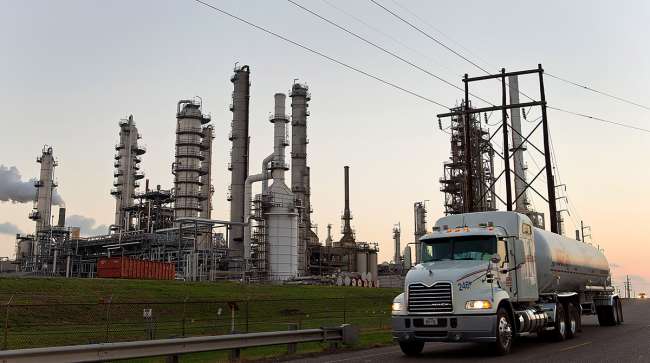Ban on Toxic Acid May Test Californians’ Thirst for Cheap Fuel

Californians are used to paying more for gasoline, but that may be tested soon if a pair of Los Angeles-area refineries are forced to stop their use of a toxic chemical.
The local air-quality regulator indicated this month that it may ban hydrofluoric acid from both PBF Energy Inc.’s Torrance refinery and one owned by Valero Energy Corp. eight miles away. The chemical, used by 35% of all U.S. refineries, boosts octane to make cleaner-burning gasoline. But some residents fear that if it were ever released, it could form a poisonous cloud that would threaten a quarter-million area lives.
Phasing out the acid may cause a surge in pump prices that dwarfs one seen in 2015, when an explosion at the Torrance refinery, then owned by Exxon Mobil Corp., raised California’s retail gasoline price by a dollar in three months. Fuel demand on the West Coast is near a 10-year high, government data show. And the price for regular gasoline at California’s pumps is already pushing $3 a gallon, more than 60 cents above the U.S. national average, according to data from AAA, the largest U.S. motoring group.
“There’s a more-than-passing chance that it could create a scarcity situation for octane,” said Vikas Dwivedi, senior analyst at Macquarie Capital Inc. in Houston. “A big pinch in octane could take prices way up. It would be pretty substantial and everybody would feel it in their wallets.”
The 150,000 barrel-a-day Torrance plant is the second-biggest in Southern California, producing a fifth of the area’s gasoline. Only California’s 19 refineries, plus a handful overseas, are able to produce gasoline that meets the state’s strict environmental fuel standards.
The 2015 explosion spurred some of the concern about using the acid, which has been controversial since the 1980s. The U.S. Chemical Safety Board called the incident, which injured four workers and almost halted fuel production for more than a year, a “near miss” after the explosion hurled a piece of machinery toward a tank of the acid.
“There’s a real crisis of confidence with the Torrance refinery,” state Assemblyman Al Muratsuchi said in a telephone interview, pointing to a series of mishaps including fires, power cuts and heavy flaring that have plagued the refinery since PBF took it over in June 2016. He has proposed legislation to phase out use of the acid in California by the end of the decade.
If limits on the acid create a scarcity in locally made fuel, Southern California would have to buy as much as 25% of its gasoline from places as far away as India and the U.K., driving prices higher, Dave Hackett, president of Irvine, California-based Stillwater Associates, said in a report last month that was commissioned and reviewed by PBF. Gasoline imports could rival or surpass 2015 levels, when they rose more than 10-fold to almost 70,000 barrels a day, he said.
“This is not an end-of-the-world scenario,” said Sally Hayati, a community resident and president of the Torrance Refinery Action Alliance, the largest activist organization, who added that a short-term price increase would be a small price to pay. “It’s an annoyance, an interruption in production, but it’s not a game changer.”
Price fears may also be overblown, Patrick Dehaan, a senior analyst at pump-price monitor Gasbuddy, said by telephone. A switch away from hydrofluoric acid “is one of those things that refineries know in advance” and the market can plan for, unlike explosions, he said.
Safety Question
Breathing hydrogen fluoride can damage, swelling and fluid accumulation in the lungs and can cause severe burns to skin, according to the U.S. Centers for Disease Control and Prevention. Breathing in high amounts can be fatal.
A phase out would cost about $500 million per refinery, according to an estimate by Gordon Schremp, senior fuels analyst for the California Energy Commission. That’s almost equal to the $538 million PBF agreed to pay for Torrance.
The acid at Torrance has been modified since 1997 with an additive that makes it less likely to spread through the air and making it safe to use, Mike Karlovich, a spokesman at PBF’s headquarters in Parsippany, New Jersey, said by telephone.
The company’s assurances haven’t convinced the South Coast Air Quality Management District, the local regulator, which said in an Aug. 2 presentation that a phase out would be a “preventative measure.” It stated that PBF “did not sufficiently demonstrate” that a hydrofluoric acid cloud could be prevented.
PBF expressed disappointment in the stance, and a Valero statement issued after it alleged the regulator was “seeking drastic changes when there have been no HF related safety issues.”
Dutch Fire
A late July fire at Royal Dutch Shell Plc’s Pernis refinery in the Netherlands which released a hydrofluoric acid cloud heightened fears of a similar event in California, even though Shell said the cloud stayed within the refinery and wasn’t in hazardous concentrations.
“The fire and acid release at the Shell refinery in Rotterdam is the latest sign that an accident could create a deadly acid plume,” Hayati said, while acknowledging there could be a “temporary impact on gasoline prices.”
Gasbuddy’s Dehaan noted that while an acid phase out might be reassuring for the refineries’ neighbors, others in the state may not be so happy.
“For Californians who aren’t in the immediate proximity of the refiners, they want to fill their tanks with as cheap gasoline as possible,” he said. “Nobody likes spending money on gas.”




